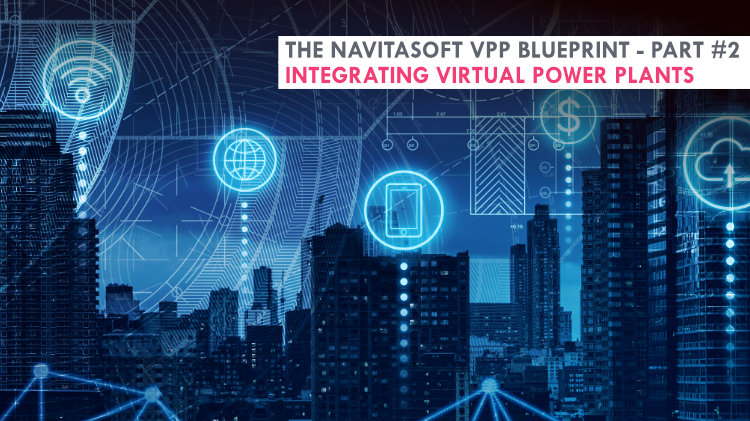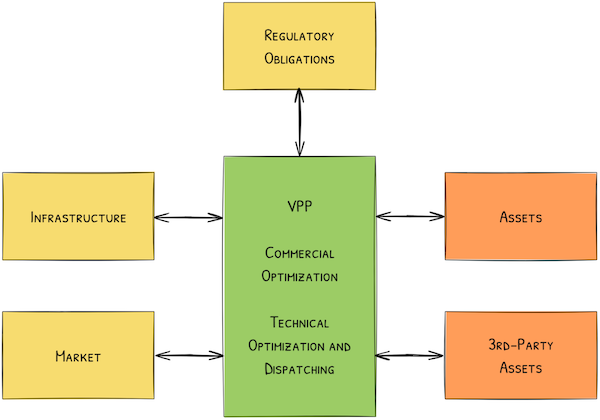
Renewable energy capacity is expected to increase by over 60% from 2020 levels, reaching around 4800 GW by 2030. This remarkable growth is driven mainly by the increasing adoption of solar, wind, and storage technologies, the full potential of which is best realized when integrated efficiently into the energy grid. This is where Virtual Power Plants (VPPs) come in.
A VPP is a network of decentralized, medium-scale power-generating units dispatched through the central control room of the VPP but remain independent in their ownership. The primary objective of a VPP is to enhance the power generation efficiency and reliability by balancing the supply and demand of electricity among multiple assets, and in many cases supporting effective integration of various renewable energy sources. They play a critical role in modern energy grids, particularly in facilitating the integration of renewable energy sources and providing grid services.
This is why VPPs stand at the forefront of the energy transition, but as they are a relatively new concept, little is known about what you must consider if you want to start one. This is why we see it as our mission to get the word out about VPPs, just like we did in our last article on “The Navitasoft VPP Blueprint,” where we talked about how proper forecasting is vital to the functioning of a VPP. This second article delves into the equally important and multifaceted world of VPP integration, exploring the nuances and complexities that underpin this critical process, and we will also shed light on the challenges and opportunities that lie ahead.

VPP Asset Integration
It all begins with the asset owner. Direct communication and dispatching of the asset is the foundation of the integration process, facilitated through advanced technologies such as SCADA/EMS/BMS or IoT, which take care of the communication with and within the assets while the Control Unit manages the fleet as a whole. The latter is essential ensuring an economically optimized signal is delivered. In case an asset fails to perform adequately, the Control Unit intervenes by deploying alternative assets, such as prompting a battery to compensate. These systems are the lifelines of VPPs, gathering and analyzing real-time data to ensure that solar panels, wind turbines, storage systems, or other conventional assets like gas motors, are not isolated entities but become integral parts of a cohesive system. The success of VPPs, therefore, heavily relies on robust communication protocols and stringent security measures, providing valuable insights into the performance of the VPP network. This enables operators to make informed decisions and optimize energy management.
To gather the correct data, you must know your asset's location and its relationship to the network topology. This also involves answering the following questions: Can the asset relieve congestion management? Is the asset located under a substation that might be redispatched? Where do the price signals come from, and are there other relevant metrics?
You must first collect detailed information about the relevant TSO or DSO substation and Point of Delivery (POD) data, typically through SCADA or Automatic Generation Control (AGC) systems. This is crucial for optimizing energy flow and effectively managing the grid. So for VPPs to operate at their peak, they must collect and analyze data from the relevant network operator. Here, data sources include TSO/DSO data portals and transparency portals, providing a wealth of information for informed decision-making. This is how physical integration in VPPs transcends basic connectivity. VPP operations must be harmonized with existing local networks to provide their much sought after flexibility that can prevent conflicts, especially in overload situations.
Prepping for Trading
One of the most transformative aspects of VPP integration is facilitating energy trading. Participating in multiple energy markets (ancillary services, capacity markets, intraday, day-ahead etc.) requires a seamless connection with TSO/DSO reserve systems and, for broader market engagement, with power exchanges or broker systems. Such integration enables VPPs to sell excess energy or procure energy as market dynamics dictate.
For VPPs operating across national borders, integrating data from Cross-Border Capacity (CBC) systems is essential. This ensures that VPPs can optimize operations across diverse regulatory landscapes and market conditions. Participation in reserve markets necessitates integration with TSO scheduling systems. This involves not only submitting planned production but also adapting to the dynamic needs of the grid. Such integration is key to maintaining grid stability and efficiency.
Technical Difficulties
But like with all emerging technologies, there are some technological hurdles: One of the primary challenges in VPP integration is the technological complexity involved. Integrating diverse energy sources, each with its unique characteristics and requirements, into a unified system demands advanced technological solutions and a deep understanding of energy systems. You must answer the question of which connection type is the best solution for a particular asset or security requirement - what IoT protocols can or should be used, or when it is better to opt for a SCADA connection. Navigating the regulatory landscape and market dynamics poses another significant challenge. VPPs must comply with various national and international regulations, which can be complex and sometimes contradictory. Moreover, engaging effectively in energy markets requires a sophisticated understanding of market mechanisms and trends.
On the other hand, the advancements in AI and machine learning could make things more simple for VPP integration. These technologies can enhance forecasting accuracy, optimize asset performance, and streamline market participation, paving the way for more efficient VPP operations.
Shaping the Future of Energy
The VPP integration can be simplified as Assets ⇔ Controller ⇔ Market, which emphasizes the seamless flow of information and control along the entire stream. Still, integrating VPPs is more than a technical process; it's a strategic endeavor that sits at the heart of the renewable energy revolution.
The future that awaits us is dominated by renewable energy, where the role of VPPs in this landscape becomes increasingly vital. Integrating VPPs is complex and challenging, but it also offers immense opportunities for innovation and growth. This is why the energy industry must continue to push the boundaries of technology and strategy to ensure a stable, efficient, and sustainable energy system for the future.
Here at Navitasoft, we specialize in navigating the complexities of integrating VPPs seamlessly into existing energy infrastructures. Our expertise lies in bridging the gap between renewable energy's potential and the practicalities of its implementation. With a focus on innovative solutions and strategic partnerships, we enable energy providers to harness the full power of their VPPs. Our services streamline the integration process and optimize performance and profitability. Let us help you transform the energy landscape by making VPP integration a smooth, efficient, and rewarding journey for a dream of renewable energy that turns into reality.
The Navitasoft VPP Blueprint
Follow our complete series on VPPs and the digital solutions needed to run them:
Part 1: Forecasting in virtual power plants
Part 2: Integrating virtual power plants
Part 3: Internal system integration and reporting
Part 4: Optimization in Virtual Power Plants
Part 5: Trading Strategies to Optimize Your VPP
Part 6: How to Manage Risk for Your Virtual Power Plant
Part 7: Dispatching & control of execution in virtual power plants
Part 8: Disaggregation and settlement in virtual power plants
Part 9: VPP 3.0 - The Third Generation of Virtual Power Plants




